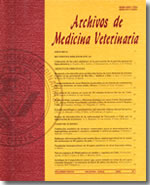Muestreo predial pequeño para predecir una infección activa por virus diarrea viral bovina (VDVB) en planteles lecheros de la Xª Región de Chile
Contenido principal del artículo
Resumen
La diarrea viral bovina está distribuida mundialmente y la mayoría del ganado es seropositivo, aunque la seroprevalencia varía entre predios y grupos de edad. Los animales con infección persistente son los transmisores más eficientes, pasan desapercibidos y son la fuente más importante para la perpetuación de la infección.
Este trabajo entrega los resultados del análisis serológico de una muestra predial de 10 animales entre 6 y 12 meses de edad de 44 predios lecheros de la X Región de Chile. Se constató que en 35 planteles (79.5%) existiría infección activa con virus diarrea viral bovina, pues al menos 6 de los 10 sueros estudiados presentaron anticuerpos. De esta manera, mediante una muestra pequeña de animales jóvenes es posible predecir, con certeza, la presencia de infección activa en los planteles.

